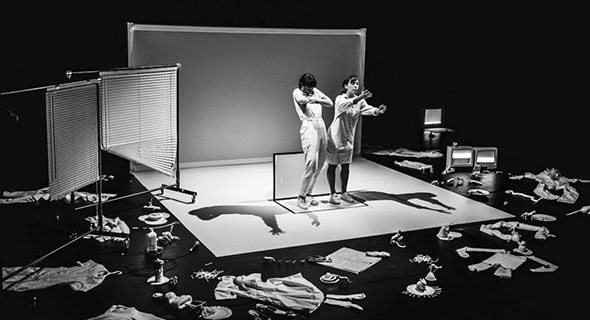Ian Abbott’s second report from RISE 2019 in Findhorn
Posted: May 5th, 2019 | Author: Ian Abbott | Filed under: Festival, Performance | Tags: Bon 4 Bon, Catherine Lavoie-Marcus, Chien-chih, Chien-hao, Chien-kuei, Eyal Dadon, Federation of Scottish Theatre, Findhorn, Harold Rheaume, Ho-chien, Janine Harrington, Karl Jay-Lewin, Katrina McPherson, Mandoline Hyrbide, Priscilla Guy, RISE 2019 | Comments Off on Ian Abbott’s second report from RISE 2019 in FindhornIan Abbott’s second report from RISE 2019, Findhorn, May 3

As an afternoon prologue to RISE, the Federation of Scottish Theatre held one of their bi-annual Dance Forums (for the third time in Findhorn) bringing together independent artists, venue managers, producers and festival programmers from across Scotland to share information, updates and engage in a discussion on a particular theme. This year discussion turned around The Role, Potential and Impact of Festivals with provocations from Janine Harrington and Karl Jay-Lewin. Harrington spoke of her experience of performing at and experiencing a range of festival contexts and left an interesting residue as she spoke of artist-as-leader, referencing H2Dance’s Fest en Fest, making herself less tidy and more complicated whilst acting as a hernia inside an organisational structure to rupture and burst it. Jay-Lewin spoke of his tri-role as artist, creative director of Dance North Scotland and the curator of RISE, saying that the people — rather than the work he programmes — have to have a desire for more than just the gig; there has to be an urge for something beyond, maybe related to the ecological/spiritual nature of Findhorn alongside a desire for community.
Jay-Lewin has been building a long-term creative relationship with Canada (and in particular Québec) and this year’s RISE presents Singeries (2016) by Mandoline Hybride alongside the world premiere of Paysages Mixtes / Dix Commandments by Scotland’s Katrina McPherson and Québec choreographer, Harold Rhéaume.
Singeries self-describes as: ‘Two women try to stay true to themselves. Trapped in the middle of a videographic fresco in which their image is multiplied and shattered, they ape and compulsively replay their own image so that they don’t completely dissolve.’ As a 60-minute festival opener it is riddled with intrigue and a lo-fi menace. Catherine Lavoie-Marcus and Priscilla Guy, who are responsible for the artistic direction, choreography and performance, are almost static downstage left as we enter the Universal Hall to an exploded Schrodinger’s box with toys, clothes, screens, blinds strewn across the stage. Guy and Lavoie-Marcus are reminiscent of a pair of analogue troubadours cornered in a world not of their choosing. As diffuse light appears and disappears no shadows are cast by Guy and Lavoie-Marcus in their whiteout, reducing our understanding and visibility as they merge with the white televisual snow surfaces. Singeries is technologically tight, narratively precise and flits our attention between screen and human worlds; the visual detail and attention is bountiful with projections splitting across venetian blinds, bodies and alternate screens.
In a conversation with Katrina McPherson in advance of the festival, she shared some of her history and experiences in screendance as well as her connection and relationship with Rhéaume. I distilled her conversation into this response:
katrina and i
in the shadows of QuebecTaitFerness
the agency of dualauthoredimages
without end weeattheeastcoast
revealing invisiblepresences
ourselvesrecorded
katrina and i
a m e l a n c h o l i c exuberance
crumbling legs
c
o
l
l
a
p
s
e
shooting m y s e l f as a montage
of female gaze
an e m b o d i e d layered e m p a t h y camera
older artists with big lives
a g a i n and a g a i n and a g a i n
pulling and cutting ourselves up
katrina and i
an e p i c e n t r e built on margins
built on buster keaton
built on banff
built on peter
built on doug
built on simon
built on anna
built on moray
built on fred astaire
an o f f c e n t r e built on commandments
I will be in conversation with Rhéaume during the festival and will offer a response to him in my next piece.
Closing out the first night was the delicious hug that is Chang Dance Theatre’s Bon 4 Bon (2017) — one of the critical successes from last year’s Edinburgh Fringe — choreographed by Eyal Dadon that frames childhood and brotherhood through collective memories of mango. Having trained together at Taipei National University of the Arts, Bon 4 Bon is the first time the four brothers (Chien-hao, Chien-chih, Chien-kuei and Ho-chien) have performed on the same stage and there is a bodily ease that can only come from decades of sibling play, fighting and familiarity. Set to Blackbird by The Beatles and 666 by Bon Iver, these 30 minutes are laced with charm as we listen to each brother replay memories of their father, mango and Taiwan. There’s a lightness to Dadon’s construction and choreography which sits well on their bodies and transmits easily to our eyes whilst nestling in the squishy feels area of the audience — leaving me not only with Blackbird as an ear worm but thinking of childhood.
We can immerse ourselves in Chang Dance Theatre performing and retracing memories, but with thoughts of childhood come thoughts of older age and I’d be interested to see how Bon 4 Bon looks in a decade or 25 years, when their bodies have changed, their lives altered and their emotional connections have deepened; there would be a richness and nuance that is unachievable in youth. Speaking with some of the artists and visitors at the festival this year the word comfort has been used a lot: RISE as comfort, Findhorn as comfort and now we can add Bon 4 Bon as comfort too.
Ian Abbott’s preview of RISE 2019 is here.